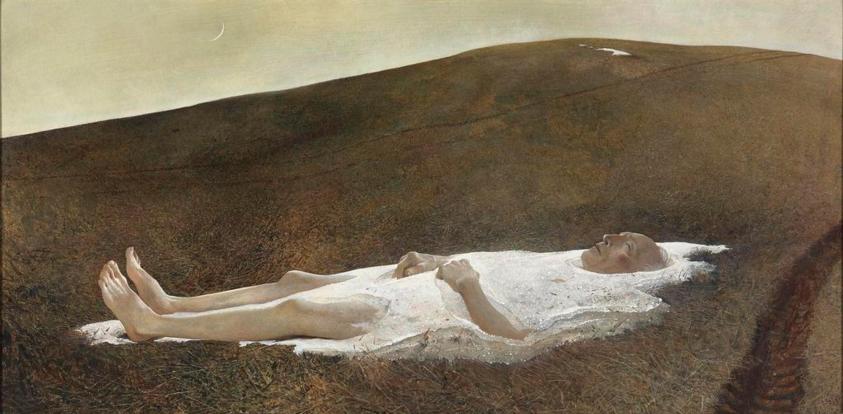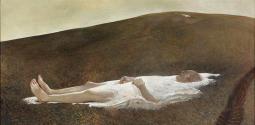Artist:
Andrew Wyeth
(American, 1917 - 2009)
Spring
Medium: Tempera on panel
Date: 1978
Dimensions:
24 × 48 in. (61 × 121.9 cm)
Accession number: 87.13
Copyright: © 2024 Wyeth Foundation for American Art / Artists Rights Society (ARS), NY
Label Copy:
Beginning in the 1930s and continuing for over five decades, the Chadds Ford farm of Karl and Anna Kuerner was at the heart of Andrew Wyeth’s artistic sphere in Pennsylvania. The couple had immigrated from Germany in the 1920s after Karl’s service in the German army as a machine gunner during World War I. Wyeth was deeply fascinated by both the couple and the farm, documenting his responses in hundreds of drawings, watercolors and temperas through the years.
In painting Karl Kuerner, Wyeth observed and depicted the passage of time as Kuerner grew older and eventually became ill with leukemia. In this surreal scene, a meditation on death and regeneration, Wyeth imagined Kuerner encased in vestiges of ice at the base of Kuerner Hill. This was a powerful location for the artist, close to the railroad tracks where his father had died so tragically in 1945, a symbolic reminder of that death.
Beginning in the 1930s and continuing for over five decades, the Chadds Ford farm of Karl and Anna Kuerner was at the heart of Andrew Wyeth’s artistic sphere in Pennsylvania. The couple had immigrated from Germany in the 1920s after Karl’s service in the German army as a machine gunner during World War I. Wyeth was deeply fascinated by both the couple and the farm, documenting his responses in hundreds of drawings, watercolors and temperas through the years.
In painting Karl Kuerner, Wyeth observed and depicted the passage of time as Kuerner grew older and eventually became ill with leukemia. In this surreal scene, a meditation on death and regeneration, Wyeth imagined Kuerner encased in vestiges of ice at the base of Kuerner Hill. This was a powerful location for the artist, close to the railroad tracks where his father had died so tragically in 1945, a symbolic reminder of that death.
Curatorial RemarksDeath is often an underlying theme in Andrew Wyeth’s work, but here, in this most surreal of his paintings, it is expressed rather directly. As Karl Kuerner, Wyeth’s friend, and surrogate father, neared his death from cancer in the late 1970s, Wyeth sketched him lying in his bed, at times lost in hallucinations of the past brought on by his illness. Kuerner was lying in bed near a window with a view of the hill beyond, and in the painting, Wyeth transports Karl’s body to the hill, placing his figure in a snowdrift instead of sheets. Elements of the painting suggest symbolic interpretations. This area of Kuerner’s farm had special significance to Wyeth; his father, N.C. Wyeth, was killed within sight of the hill, when his car was struck by a train. In Spring, Wyeth merges his two fathers, the essence of one seemingly melting into the other, as the artist comes to terms with another loss.
The artist said he hopes people will notice the other drift at the top of the hill and ask, "Who’s in there?" A deep track next to the figure indicates the thawing of the earth. Another set of tracks spans the width of the hill. At the top of the painting, the sliver of a moon appears in the thin strip of sky. Reactions to this work vary, from a young child’s literal view of a man who died in a snowdrift, to an adult’s perception of an artist commenting on death and life in this stark painting. In contrast to the bleak image, the painting’s title, Spring, suggests renewal, thawing out and the natural passage of time and seasons.
The artist said he hopes people will notice the other drift at the top of the hill and ask, "Who’s in there?" A deep track next to the figure indicates the thawing of the earth. Another set of tracks spans the width of the hill. At the top of the painting, the sliver of a moon appears in the thin strip of sky. Reactions to this work vary, from a young child’s literal view of a man who died in a snowdrift, to an adult’s perception of an artist commenting on death and life in this stark painting. In contrast to the bleak image, the painting’s title, Spring, suggests renewal, thawing out and the natural passage of time and seasons.

